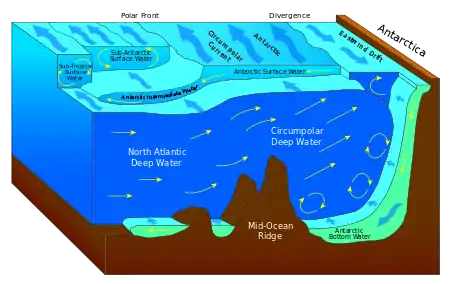Hydrothermal circulation
Hydrothermal circulation in its most general sense is the circulation of hot water (Ancient Greek ὕδωρ, water,[1] and θέρμη, heat [1]). Hydrothermal circulation occurs most often in the vicinity of sources of heat within the Earth's crust. In general, this occurs near volcanic activity, but can occur in the deep crust related to the intrusion of granite, or as the result of orogeny or metamorphism.
Seafloor hydrothermal circulation
Hydrothermal circulation in the oceans is the passage of the water through mid-oceanic ridge systems.
The term includes both the circulation of the well-known, high-temperature vent waters near the ridge crests, and the much-lower-temperature, diffuse flow of water through sediments and buried basalts further from the ridge crests. The former circulation type is sometimes termed "active", and the latter "passive". In both cases, the principle is the same: Cold, dense seawater sinks into the basalt of the seafloor and is heated at depth whereupon it rises back to the rock-ocean water interface due to its lesser density. The heat source for the active vents is the newly formed basalt, and, for the highest temperature vents, the underlying magma chamber. The heat source for the passive vents is the still-cooling older basalts. Heat flow studies of the seafloor suggest that basalts within the oceanic crust take millions of years to completely cool as they continue to support passive hydrothermal circulation systems.
Hydrothermal vents are locations on the seafloor where hydrothermal fluids mix into the overlying ocean. Perhaps the best-known vent forms are the naturally occurring chimneys referred to as black smokers.
Volcanic and magma related hydrothermal circulation
Hydrothermal circulation is not limited to ocean ridge environments. The source water for hydrothermal explosions, geysers, and hot springs is heated groundwater convecting below and lateral to the hot water vent. Hydrothermal circulating convection cells exist any place an anomalous source of heat, such as an intruding magma or volcanic vent, comes into contact with the groundwater system.
Deep crust
Hydrothermal also refers to the transport and circulation of water within the deep crust, in general from areas of hot rocks to areas of cooler rocks. The causes for this convection can be:
- Intrusion of magma into the crust
- Radioactive heat generated by cooled masses of granite
- Heat from the mantle
- Hydraulic head from mountain ranges, for example, the Great Artesian Basin
- Dewatering of metamorphic rocks, which liberates water
- Dewatering of deeply buried sediments
Hydrothermal circulation, in particular in the deep crust, is a primary cause of mineral deposit formation and a cornerstone of most theories on ore genesis.
Hydrothermal ore deposits
During the early 1900s, various geologists worked to classify hydrothermal ore deposits that they assumed formed from upward-flowing aqueous solutions. Waldemar Lindgren (1860–1939) developed a classification based on interpreted decreasing temperature and pressure conditions of the depositing fluid. His terms: "hypothermal", "mesothermal", "epithermal" and "teleothermal", expressed decreasing temperature and increasing distance from a deep source.[2] Recent studies retain only the epithermal label. John Guilbert's 1985 revision of Lindgren's system for hydrothermal deposits includes the following:[3]
- Ascending hydrothermal fluids, magmatic or meteoric water
- Porphyry copper and other deposits, 200–800 °C, moderate pressure
- Igneous metamorphic, 300–800 °C, low to moderate pressure
- Cordilleran veins, intermediate to shallow depths
- Epithermal, shallow to intermediate, 50–300 °C, low pressure
- Circulating heated meteoric solutions
- Mississippi Valley-type deposits, 25–200 °C, low pressure
- Western US uranium, 25–75 °C, low pressure
- Circulating heated seawater
- Oceanic ridge deposits, 25–300 °C, low pressure
References
- Liddell, H.G. & Scott, R. (1940). A Greek-English Lexicon. revised and augmented throughout by Sir Henry Stuart Jones. with the assistance of. Roderick McKenzie. Oxford: Clarendon Press.
- W. Lindgren, 1933, Mineral Deposits, McGraw Hill, 4th ed.
- Guilbert, John M. and Charles F. Park, Jr., 1986, The Geology of Ore Deposits, Freeman, p. 302 ISBN 0-7167-1456-6

